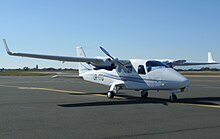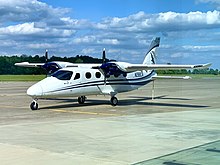41°07′13″N 14°11′04″E / 41.12030°N 14.18444°E / 41.12030; 14.18444
| Company type | Private |
|---|---|
| Industry | Aerospace |
| Founded | 1986 (1986) |
| Founders | |
| Headquarters | Naples International Airport, Casoria, Italy |
| Area served | Worldwide |
| Key people |
|
| Website | tecnam |
Costruzioni Aeronautiche TECNAM S.p.A., commonly known as simply Tecnam, is an Italian aircraft manufacturer. The company has two primary activities: producing aircraft components for various other manufacturers, and manufacturing its own range of light aircraft. The company was founded in 1986 by Italian brothers Luigi Pascale and Giovanni Pascale, veteran aircraft designers and manufacturers. Prior to creating Tecnam, they had been responsible for several other aviation-related projects, including the design and construction of the twin-engine Partenavia P.68. Their original intent in founding Tecnam was to build aerospace parts on behalf of other manufacturers, which initially included American aerospace company Boeing and commuter airliner specialist ATR. When the light-sport aircraft market began to emerge, the brothers entered the field, first with the Tecnam P92, which was well received.
Tecnam operates two separate production facilities in Italy; the Casoria facility is located adjacent to Naples International Airport. The Capua facility is located adjacent to the Oreste Salomone Airport. The company also operates sales and delivery facilities in Sebring, Florida, United States and Australia. As of 2018, it has delivered 5,000 airplanes worldwide and employs 250 people. The founding brothers have both died, but Luigi's nephew, Paolo, is CEO and his son, Giovanni is director of operations.
History

Tecnam have produced a range of aircraft, most suited towards the general aviation sector. Its light sport aircraft currently in production feature side-by-side twin-seat configurations, aluminum monocoque construction, and are powered by the 100 hp Rotax 912S engine. There are several models manufactured, adopting both high- and low-wing layouts, some furnished with retractable undercarriages. In some cases, one model has two different designations, one for flight under the ultralight aviation regulations, and the other for flight under general aviation regulations as a regular certified light aircraft. Many of the aircraft fall within new sub-categories of certified aircraft, e.g. the EASA VLA (very light aircraft) rules in Europe and LSA rules in the United States.

By 2005, one particular aircraft, the Tecnam P2002 Sierra, had risen to prominence in Tecnam's lineup, the company having dedicated around 70 percent of its total aircraft production capacity to manufacturing the Sierra alone. By this point, the aircraft was being produced at a rate of six per week, while the company claimed to have an order backlog spanning the following six months. Furthermore, the Sierra could also be supplied in a near 'ready to go' configuration suited to the European trainer market, which was one reported consequence of having secured its VLA certification. By mid-2005, Tecnam had reportedly completed delivery of roughly 180 Sierras.

The Tecnam P2006T, a four-seat twin engined aircraft, made its maiden flight in 2007. It is powered by a pair of 100 hp Rotax 912S piston engines, driving variable pitch propellers, and retractable landing gear. The P2006T was certified by the EASA during 2009, while Part 23 certification was issued by the Federal Aviation Administration during the following year. In addition to its general aviation usage, the P2006T can be operated in other capacities, including as a maritime patrol aircraft, a specially furnished multi-mission model has been developed for military uses.
During the late 2000s, the company also developed the Tecnam P2008, performing its maiden flight on September 30, 2008. It is notable for being the first Tecnam-built aircraft to incorporate major composite components, such as its carbon fibre fuselage. It is otherwise conventional, using a traditional strut braced high-wing monoplane configuration, being powered by a single Rotax 912ULS flat four piston engine, and furnished with a fixed tricycle undercarriage. During December 2009, the firm made its first deliveries of the P2008. The Tecnam P2010 is a larger, four seat derivative of the P2008.
During October 2015, the company announced that it has formed a partnership with Chinese aircraft manufacturer Liaoning United Aviation, a division of Shenyang Aircraft Corporation, to produce the Chinese-certified P2006T at its facility adjacent to Faque Airport in China, for delivery to customers throughout the Chinese market, including Hong Kong, Macao and Taiwan. Additional aircraft, including the two-seat Tecnam P2008JC and the four-seat Tecnam P2010, shall also be produced at the same facility once certified by local authorities.
That same year, it was announced that Tecnam was working on its first jet-powered aircraft, referred to as the P-Jet; this aircraft is intended for use as a light military trainer or reconnaissance aircraft. Powered by a single engine turbofan engine, it shall feature a side-by-side seating arrangement and retractable tricycle landing gear, along with a twin rudder arrangement.

Throughout the 2010s, Tecnam developed their first commercial aircraft, the P2012 Traveller; it is being marketed towards the commuter airliner, VIP, cargo, parachuting and medevac sectors of the market. Publicly revealed in April 2011, and having performed its maiden flight on July 21, 2016, it received type certification from the Federal Aviation Administration during August 2019, As of 2017, the company can reportedly produce up to 40 P2012s per year. Tecnam has forecast a demand for 11,500 short-haul commuter aircraft between 2018 and 2028.
During 2017, Tecnam reportedly built around 200 aircraft; it had a target to build a similar amount during the following year. According to aerospace periodical Flight International, the firm's recent sales have been dominated by two aircraft, the four-seat P2006 and two-seat P2008. During 2018, the company stated that it is considering establishing additional production capacity, including another factory, if demand for its aircraft justifies the investment involved in undertaking such an expansion.
Products
| Model name | First flight | Number built | Type |
|---|---|---|---|
| Tecnam P92 | 1993 | Single piston engine monoplane utility airplane | |
| Tecnam P96 Golf | 1996 | Single piston engine monoplane utility airplane | |
| Tecnam P2002 Sierra | Single piston engine monoplane utility airplane | ||
| Tecnam P2004 Bravo | 2002 | Single piston engine monoplane utility airplane | |
| Tecnam P2006T | 2007 | 578 | Twin piston engine monoplane utility airplane |
| Tecnam P2008 | 2008 | Single piston engine monoplane utility airplane | |
| Tecnam P2010 | 2012 | 245 | Single piston engine monoplane utility airplane |
| Tecnam P2012 Traveller | 2016 | Twin piston engine monoplane utility airplane | |
| Tecnam Astore | 2013 | 30 | Single piston engine monoplane utility airplane |
| Tecnam P-Jet | Single jet engine monoplane trainer | ||
| Tecnam P-Mentor | Single piston engine monoplane trainer |
See also
References
- ^ Tacke, Willi; Boric, Marino (2015). World Directory of Light Aviation 2015–16. Flying Pages Europe. pp. 82–83. ISSN 1368-485X. OCLC 1013186505.
- Garvey, William (May 22, 2018). "Italy's Tecnam boasts clients from regional airliners to NASA". Aviation Week & Space Technology.
- ^ Collins, Peter (July 19, 2005). "FLIGHT TEST FLY OFF: Evektor SportStar, Flight Design CT, Tecnam Sierra – Sporting heroes". Flight International.
- Bergqvist, Pia (September 2011). "Tecnam Twin". Flying. pp. 52–59.
- "EASA Type Certificate Data Sheet A.185" (PDF). Archived from the original (PDF) on October 27, 2016. Retrieved October 26, 2016.
- "Tecnam". www.airbornetechnologies.at.
- Yanez, Roberto (January 2013). "Tecnam's low-cost surveillance twin". Combat Aircraft. 14 (1). Stamford, Lincolnshire: Key Publishing: 19. ISSN 2041-7470.
- ^ Bayerl, Robby; Berkemeier, Martin (2011). World Directory of Leisure Aviation 2011–12. Lancaster UK: WDLA UK. p. 80. ISSN 1368-485X. OCLC 1013186505.
- Jackson, Paul (2011). Jane's All the World's Aircraft 2011-12. Redhill, UK: IHS Jane's. pp. 394, 396. ISBN 978-0-7106-2955-5.
- "Tecnam Partners with Chinese Manufacturer". avweb.com. October 2015.
- Min, Yang (January 18, 2018). "Faku obtains Tecnam P2006T Aircraft certification". China Daily.
- Bergqvist, Pia (May 12, 2015). "Tecnam Explores Two-Seat P Jet". Flying Magazine. Retrieved June 7, 2015.
- ^ "AERO11: Tecnam unveils three new aircraft". Flightglobal. April 13, 2011.
- "Tecnam P2012 Traveller takes flight". Flight Global. July 25, 2016.
- Hemmerdinger, Jon (August 16, 2019). "FAA approval brings first P2012 delivery to Cape Air closer". Flightglobal.
- Jackson, Paul (October 8, 2017). "Emerging Aircraft: Props And Turboprops". Aviation Week Network.
- Sarsfield, Kate (October 30, 2018). "Tecnam wraps up P2012 Traveller certification testing". Flightglobal.
- Morrison, Murdo (November 20, 2018). "How Tecnam and Cape Air created the P2012". Flight Global.
- Sarsfield, Kate (January 8, 2018). "Tecnam flies second P2012 Traveller". Flight Global.
External links
![]() Media related to Tecnam at Wikimedia Commons
Media related to Tecnam at Wikimedia Commons
| Aircraft produced by Tecnam | |
|---|---|